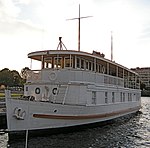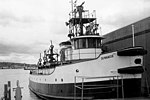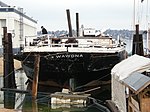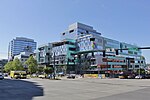Arthur Foss

Arthur Foss, built in 1889 as Wallowa at Portland, Oregon, is likely the oldest wooden tugboat afloat in the world. Its 79-year commercial service life began with towing sailing ships over the Columbia River bar, and ended with hauling bundled log rafts on the Strait of Juan de Fuca in 1968. Northwest Seaport now preserves the tug as a museum ship in Seattle, Washington.The tug's long service in the Pacific Northwest, including a role in the Klondike Gold Rush, was interrupted by preparations for war in early 1941. After delivering a drydock gate to Pearl Harbor the tug was chartered by Contractors Pacific Naval Air Bases, a consortium formed to build air fields on remote Pacific islands as the United States prepared for war. In June 1941 Arthur Foss was supporting construction on Wake Island and was there in November along with the smaller Justine Foss transporting construction materials from barges in the lagoon to the island. When the work was completed the tug was scheduled to return to Hawaii with two barges in tow. The captain, concerned about the warnings of war, left the island without refueling. The smaller tug had to refuel and remained to do so. Arthur Foss was about twelve hours into the voyage to Honolulu when word of the attack on Pearl Harbor was received. The tug's crew repainted the tug with what paint was available and kept radio silence. The tug, overdue and thought lost, was spotted by Navy patrol planes and made Pearl Harbor on 28 December with fuel for less than a day's operation left. The crew of Justine Foss were captured when the island was taken by the Japanese with all but one eventually executed. The Navy put Arthur Foss in service as a yard tug under the name Dohasan from early 1942 until February 1945. The tug was laid up until 1947 when it was returned to Foss and transported to its home area where it was rehabilitated for company service in 1948. It served the company for twenty more years until retirement in July 1968.
Excerpt from the Wikipedia article Arthur Foss (License: CC BY-SA 3.0, Authors, Images).Arthur Foss
Terry Avenue North, Seattle Capitol Hill
Geographical coordinates (GPS) Address Phone number Website Nearby Places Show on map
Geographical coordinates (GPS)
| Latitude | Longitude |
|---|---|
| N 47.628055555556 ° | E -122.33694444444 ° |
Address
Northwest Seaport
Terry Avenue North
98109 Seattle, Capitol Hill
Washington, United States
Open on Google Maps











